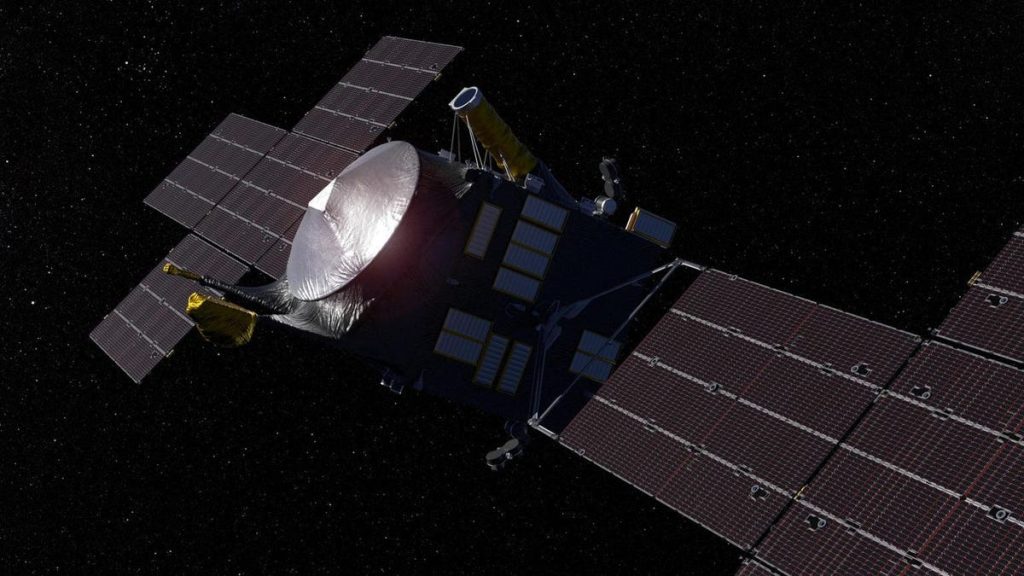The first-ever mission to explore a metal-rich asteroid, NASA’s Psyche mission—due to launch on October 5 from Florida—is catching the imagination. Is it because it’s been said to be worth $10,000 quadrillion? Probably, but this mission will be worth watching for many other reasons. Not only will it beam back incredible images, but minutes after launch on a SpaceX Heavy vehicle two reusable rockets will return to Earth to land in tandem.
Here are seven things you didn’t know about NASA’s Psyche mission to the Psyche asteroid in the main belt between Mars and Jupiter:
1. The Asteroid Could Be The Core Of A Planet
Psyche is the densest object in the solar system and from examining its light planetary astronomers think it’s primarily comprised of metals other than iron and nickel—possibly gold. That could make it the ancient, exposed core of a failed planet. That makes it a unique opportunity to study something akin to what’s at the center of our own planet, somewhere we can obviously never go.
2. It’s Not Really Worth $10,000 Quadrillion
Back in 2017 when the Psyche mission was green-lit, the mission’s principal investigator, Lindy Elkins-Tanton at Arizona State University, did a fun and very basic calculation. Asked during an interview with PBS how much the asteroid would be worth on the current metals market, she came up with $10,000 quadrillion. People believed it. But it cannot be true in practical terms. Firstly, it’s way too far way to be mined, NASA isn’t bringing any samples back and of course it can’t be towed back into Earth’s orbit. Even if the asteroid could be brought back to Earth it would crash the metals market and be worthless. Still, the calculation gotten the mission a lot of media coverage.
3. The Asteroid Could Be Golden-Green
It may be metal, but anything other than iron and nickel with will dissolved within those metals. There will be no shiny metallic surface. “No one’s gone to Psyche, cut it up and and polished it,” said Elkins-Tanton in a press briefing. “It’s been hanging out in space getting solar wind hitting it for a really long time.” However, there is a possibility that Psyche used to host sulfur volcanoes, in which case some of its surface could have a golden-green tint.
4. It Will Launch From The ‘Apollo Pad’
The Psyche mission is scheduled to launch at 10:38 a.m. EDT on Thursday, October 5, 2023. It will launch out of the historic launch complex 39A at Kennedy Space Center. This launchpad was originally built for the Saturn V program in the 1960s, which launched all the crewed Apollo missions to the moon. It’s also where the Space Shuttle launched from. It’s presently being leased by SpaceX for its Falcon 9 and Falcon Heavy launch vehicles.
5. Two Reusable Rockets Will Land In Tandem
Although its central core drops into the ocean, the SpaceX Falcon Heavy uses two reusable rockets as side boosters. About two minutes after launch they will separate, descend and land in tandem each other at Cape Canaveral Spaceport Station.
6. The Spacecraft’s Engines Are Very Weak
The Psyche’s massive solar panels—which have 800 square feet of solar collecting surface—will fuel its solar electric propulsion system for its five-and-a-half year cruise and the two years of operation around Psyche. It works by accelerating and expelling charged atoms (ions) of xenon gas, thus creating a thrust. As it prepares for launch the spacecraft hosts 2,392 pounds (1,085 kilograms) of xenon.
“The thrust produced by these engines is equivalent to the weight of AA battery sitting in the palm of your hand,” said Henry Stone, project manager, Psyche at the Jet Propulsion Laboratory in Pasadena, California, in a press briefing. However, unlike chemical engines on spacecraft these thrusters will be working 24/7. “With the engines operating continuously the spacecraft will pick up thousands of miles per hour speed in order to reach our destination,” said Stone.
7. It Will Slingshot Past Mars In 2026
That kind of engine is only possible because gravity assists are possible when moving around the solar system. Psyche’s six-year, 2.2 billion miles (3.6 billion kilometers) journey will be hugely helped in May 2026 when it slingshots around Mars, giving it a huge dollop of extra speed. Once it arrives in 2029 it will orbit 16 Psyche for 26 months, mapping and studying the asteroid’s properties.
Wishing you clear skies and wide eyes.
Read the full article here










